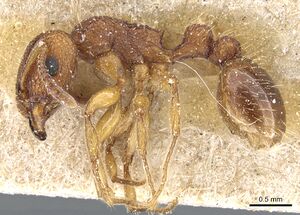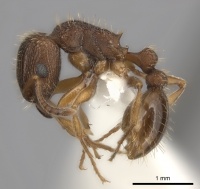Tetramorium erectum
| Tetramorium erectum | |
|---|---|

| |
| Scientific classification | |
| Kingdom: | Animalia |
| Phylum: | Arthropoda |
| Class: | Insecta |
| Order: | Hymenoptera |
| Family: | Formicidae |
| Subfamily: | Myrmicinae |
| Tribe: | Crematogastrini |
| Genus: | Tetramorium |
| Species: | T. erectum |
| Binomial name | |
| Tetramorium erectum Emery, 1895 | |
| Synonyms | |
| |
Specimen records show this species lives in open to semi-open habitats (e.g., grassland, bushland, fynbos, woodland) and is common in South Africa.
Identification
Bolton (1980) - A member of the T. emeryi species complex in the Tetramorium bicarinatum species group. Amongst the African species of the bicarinatum-group T. erectum and Tetramorium emeryi share a petiole structure which differs from that of the remainder in that the node is quite high and short and has blunted or rounded anterodorsal and posterodorsal angles, and is broad in dorsal view. Elsewhere in the group the node tends to be longer and lower, and to have sharp or even prominent angles. Of the two species thus isolated T. emeryi is distinguished by its very short propodeal teeth and distinct transverse crest on the alitrunk, whilst T. erectum is characterized by the strangely elevated propodeal spines. In fact, this one character will quickly distinguish T. erectum from all its relatives.
Keys including this Species
Distribution
Latitudinal Distribution Pattern
Latitudinal Range: 4.166667° to -34.475°.
| North Temperate |
North Subtropical |
Tropical | South Subtropical |
South Temperate |
- Source: AntMaps
Distribution based on Regional Taxon Lists
Afrotropical Region: Botswana, Democratic Republic of Congo, Namibia, South Africa (type locality), Uganda.
Distribution based on AntMaps
Distribution based on AntWeb specimens
Check data from AntWeb
Countries Occupied
| Number of countries occupied by this species based on AntWiki Regional Taxon Lists. In general, fewer countries occupied indicates a narrower range, while more countries indicates a more widespread species. |

|
Estimated Abundance
| Relative abundance based on number of AntMaps records per species (this species within the purple bar). Fewer records (to the left) indicates a less abundant/encountered species while more records (to the right) indicates more abundant/encountered species. |

|
Biology
Tetramorium erectum has been collected in soil, from the ground, and on vegetation. Hamish Robertson's excellent field notes provide the following information about habitat and nesting conditions:
SAM-HYM-C007541 - Renosterbos, SSW-facing slope. Nest in soil < 10cm below ground surface. Method: saw nest/nest entrance. Habitat: renosterbos. Nest site: grou nd: underground.
SAM-HYM-C007546 - Renosterbos, riverine bush. Entrance in small patch (0.75x0.75m) of open bare ground among 1m high vegetation. Entrance a loose turret of soil particles c 12cm wide broadening to a base 37mm wide; 15mm high. Soil moist and loamy. Workers and larvae in small cavities linked by worker-width tunnels within top 5cm of soil (but nest might have gone down further).
SAM-HYM-C007547 - Renosterbos, riverine bush. Open nest entrance in clearing between 1.5m high bushes. Entrance with small turret of loose soil c1cm high. Moist loamy soil.. Method: saw nest/nest entrance.
SAM-HYM-C007553 - Renosterbos, S-facing slope. Workers found in soil while excavating other nest.. Method: found while excavating another nest.
SAM-HYM-C009415 - Fynbos site. Nest in 10cm thick rotten log on ground.
SAM-HYM-C013776 - Nest in soil under rock.
Castes
Worker
Images from AntWeb
   
| |
| Worker. Specimen code casent0249024. Photographer Ryan Perry, uploaded by California Academy of Sciences. | Owned by AFRC, Pretoria, South Africa. |
   
| |
| Syntype of Tetramorium erectum. Worker. Specimen code casent0904837. Photographer Z. Lieberman, uploaded by California Academy of Sciences. | Owned by MSNG, Genoa, Italy. |
Nomenclature
The following information is derived from Barry Bolton's Online Catalogue of the Ants of the World.
- erectum. Tetramorium guineense var. erectum Emery, 1895h: 37 (w.) SOUTH AFRICA. Raised to species and senior synonym of bacchus: Bolton, 1980: 269.
- bacchus. Tetramorium bacchus Forel, 1910e: 426 (w.) SOUTH AFRICA. Junior synonym of erectum: Bolton, 1980: 269.
Unless otherwise noted the text for the remainder of this section is reported from the publication that includes the original description.
Description
Worker
Bolton (1980) - TL 4.2-5.0, HL 0.98-1.18, HW 0.83-1.06, CI 84-90, SL 0.62-0.76, SI 70-78, PW 0.64-0.79, AL 1.08—1.40 (20 measured).
Mandibles smooth and shining with scattered pits (when clean, a number of specimens examined have a waxy surface film which when dirty makes them seem shagreened). Anterior clypeal margin with a distinct median notch or impression. Median portion of clypeus usually without the three strong carinae generally present in this group, but in isolated specimens one or more may be present. In general the clypeus with a series of weak longitudinal rugulae. Lateral margination of median portion of clypeus strong, anteriorly fusing with the clypeal apron, posteriorly continuous with the lobes of the frontal carinae. Frontal carinae strong but occipitally merging with the rugoreticulum there present. Eyes of moderate size, maximum diameter 0.23-0.29, about 0.26-0.29 x HW. Propodeal spines in profile variable in length and thickness but always strongly elevated, often also upcurved along their length so that in many samples the apices of the spines are directed vertically. Metapleural lobes triangular and upcurved. Petiole in profile bluntly nodiform, with rounded or blunt antero- and posterodorsal angles. In dorsal view the node slightly broader than long and broader behind than in front. Dorsum of head longitudinally rugose to the level of the posterior margins of the eyes, behind with a conspicuous rugoreticulum present. Dorsal surfaces of alitrunk, petiole and postpetiole reticulate-rugose, often with a fairly distinctive punctulate groundsculpture but this last by no means universal. Transverse crest of dorsal alitrunk feeble or absent at point of junction of pro- and mesonotum. Base of first gastral tergite with a few week costulae, the spaces between them shagreened or finely punctulate. All dorsal surfaces of head and body with numerous strong hairs. Colour uniform dark brown.
Type Material
Bolton (1980) - Syntype workers, SOUTH AFRICA: Vrijburg (E. Simon) (Museo Civico di Storia Naturale, Genoa). Tetramorium bacchus. Syntype workers, SOUTH AFRICA: Natal (Haviland) (Musee d'Histoire Naturelle Genève) [examined].
References
- Bolton, B. 1980. The ant tribe Tetramoriini (Hymenoptera: Formicidae). The genus Tetramorium Mayr in the Ethiopian zoogeographical region. Bulletin of the British Museum (Natural History) Entomology. 40(3):193-384.
- Emery, C. 1895i. Voyage de M. E. Simon dans l'Afrique australe (janvier-avril 1893). 3e mémoire. Formicides. Ann. Soc. Entomol. Fr. 64: 15-56 (page 37, worker described)
References based on Global Ant Biodiversity Informatics
- Arnold G. 1917. A monograph of the Formicidae of South Africa. Part III. Myrmicinae. Annals of the South African Museum. 14: 271-402.
- Bolton B. 1980. The ant tribe Tetramoriini (Hymenoptera: Formicidae). The genus Tetramorium Mayr in the Ethiopian zoogeographical region. Bulletin of the British Museum (Natural History). Entomology 40: 193-384.
- Forel A. 1910. Note sur quelques fourmis d'Afrique. Annales de la Société Entomologique de Belgique 54: 421-458.
- Koch F., and K. Vohland. 2004. Ants along a southern African transect - a basis for biodiversity change monitoring (Insecta, Hymenoptera, Formicidae). Zoosystematics and Evolution 80(2): 261-273.
- Lindsey P. A., and J. D. Skinner. 2001. Ant composition and activity patterns as determined by pitfall trapping and other methods in three habitats in the semi-arid Karoo. Journal of Arid Environments 48: 551-568.
- Wheeler W. M. 1922. Ants of the American Museum Congo expedition. A contribution to the myrmecology of Africa. VIII. A synonymic list of the ants of the Ethiopian region. Bulletin of the American Museum of Natural History 45: 711-1004

